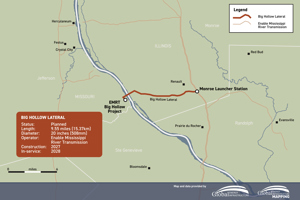
Energy Transfer Unit Seeks Approval for Illinois–Missouri Pipeline Serving Big Hollow Gas Plant
Energy Transfer’s Enable Mississippi River Transmission has proposed the Big Hollow Project, a 9.6-mile, 20-inch pipeline linking its Illinois system to Ameren’s planned Big Hollow Energy Center in Missouri.
By Mary Holcomb, Digital Lead
(P&GJ) — The Federal Energy Regulatory Commission (FERC) has opened the environmental review for Enable Mississippi River Transmission, LLC’s (EMRT) proposed Big Hollow Project, a new gas lateral designed to serve Ameren’s planned generation at the Big Hollow Energy Center in the Midwest.
In an Oct. 21 notice, FERC said it will prepare an environmental document to evaluate the impacts of the project, which would involve construction and operation of new facilities in Monroe County, Illinois, and Jefferson County, Missouri. The Commission will use that document in deciding whether the project is in the public convenience and necessity under the Natural Gas Act.
According to EMRT’s filing, the Big Hollow Project would include an approximately 9.6-mile, 20-inch-diameter lateral pipeline from a point of interconnection on EMRT’s existing 22-inch-diameter Mainline 2 and 26-inch-diameter Mainline pipelines at Mile Post 415.5 in Monroe County, Illinois, to the existing Big Hollow Energy Center site in Jefferson County, Missouri.
Pipeline Route and Information
For an overview of this project and other related infrastructure developments, visit Global Energy Infrastructure.
The project is designed to provide about 200,000 million standard cubic feet of natural gas per day to the Big Hollow Energy Center. EMRT states that the project would “facilitate Ameren’s new gas-fired generation at the Big Hollow Energy Center on the site of their retired Rush Island Energy Center.”
In addition to the new lateral, the project would add:
- A measurement and regulation station at the Big Hollow Energy Center site; and
- Appurtenant pipeline facilities, including a 20-inch pig launcher, 20-inch pig receiver, and a 20-inch hot tap on the existing Mainline 2 and Mainline 3 locations.
FERC estimates that construction would disturb about 129 acres of land for the pipeline and aboveground facilities. After construction, EMRT would maintain about 78 acres for permanent operation, with the remaining acreage restored and allowed to revert to previous uses.
The Commission has opened a National Environmental Policy Act (NEPA) scoping period to gather public and agency input on potential environmental impacts, alternatives and mitigation measures. Comments must be received in Washington, D.C., by 5:00 p.m. Eastern Time on Nov. 28, 2025.
“The main goal of the scoping process is to focus the analysis in the environmental document on the important environmental issues,” FERC staff noted, adding that the review will address topics including geology and soils, water resources and wetlands, vegetation and wildlife, threatened and endangered species, cultural resources, land use, air quality and noise, and reliability and safety.
FERC also reiterates that, if the project is approved, the Natural Gas Act would grant EMRT eminent domain authority to acquire necessary easements if voluntary negotiations with landowners fail. Any condemnation actions and compensation determinations would be handled by the courts under state law; the Commission does not exercise or oversee eminent domain.
Following scoping, FERC staff will decide whether to prepare an Environmental Assessment (EA) or a more detailed Environmental Impact Statement (EIS).
For EMRT and Ameren, the Big Hollow Project marks a key new-build lateral aimed at feeding new gas-fired generation at a legacy power site, while for midstream stakeholders it signals another example of targeted pipeline expansions to support grid reliability and power-sector demand in the Midwest.
In 2021, Energy Transfer completed its acquisition of Enable Midstream Partners, a deal approved by Enable’s largest unitholders, CenterPoint Energy and OGE Energy. The merger closed on December 2, 2021, ending Enable’s trading on the NYSE. At the time of closing, Energy Transfer emphasized that the transaction was immediately accretive and supported its broader deleveraging strategy.
The acquisition expanded Energy Transfer’s asset base to more than 114,000 miles of pipelines, at the time, and related midstream infrastructure across 41 states, further consolidating its role as one of the largest midstream operators in the United States. Company officials projected more than $100 million in annual cost and efficiency synergies, not including additional potential commercial or financial benefits.
Enable’s portfolio added major natural gas gathering and processing networks in the Anadarko, Arkoma and Haynesville regions, along with approximately 14,000 miles of gathering systems, 2.6 Bcf/d of processing capacity, 7,800 miles of interstate pipelines, 2,200 miles of intrastate pipelines, and 84.5 Bcf of natural gas storage capacity. These assets bolstered Energy Transfer’s existing gas transportation and midstream footprint across key U.S. producing basins.
The transaction also included a $10 million cash payment for Enable’s general partner.

